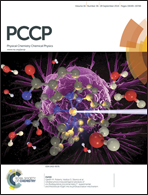Electronic transport, transition-voltage spectroscopy, and the Fano effect in single molecule junctions composed of a biphenyl molecule attached to metallic and semiconducting carbon nanotube electrodes
Abstract
We have investigated electronic transport in a single-molecule junction composed of a biphenyl molecule attached to a p-doped semiconductor and metallic carbon nanotube leads. We find that the current–voltage characteristics are asymmetric as a result of the different electronic natures of the right and left leads, which are metallic and semiconducting, respectively. We provide an analysis of transition voltage spectroscopy in such a system by means of both Fowler–Nordheim and Lauritsen–Millikan plots; this analysis allows one to identify the positions of resonances and the regions where the negative differential conductance occurs. We show that transmittance curves are well described by the Fano lineshape, for both direct and reverse bias, demonstrating that the frontier molecular orbitals are effectively involved in the transport process. This result gives support to the interpretation of transition voltage spectroscopy based on the coherent transport model.


 Please wait while we load your content...
Please wait while we load your content...